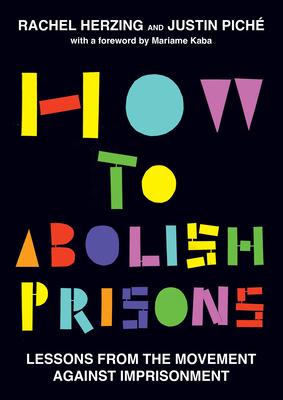An incisive guide to abolitionist strategy, and a love letter to the movement that made this moment possible.
Critics of abolition sometimes castigate the movement for its utopianism, but in How to Abolish Prisons, long-time organizers Rachel Herzing and Justin Pich reveal a movement that has made the struggle for abolition as real as the institutions they are fighting against.
Drawing on extensive interviews with abolitionist crews all over North America, Herzing and Pich provide a collective reconstruction of what the grassroots movement to abolish prisons actually is, what initiatives it has launched, how it organizes itself, and how its protagonists build the day-to-day practice of politics. Readers sit in on the Winnipeg rideshares of Bar None and the meetings of the Chicago Community Bail Fund as they assess the utility of politicized mutual aid. They follow the campaigns and coalitions of Critical Resistance in Oakland and San Francisco and Survived and Punished in New York City, and learn about the prisoner correspondence projects that keep activists behind bars and outside them in constant coordination.
Abolitionist campaigns are constructing on-the-ground initiatives across North America to deconstruct carceral society and build resistant communities.Through the words, deeds, and personalities of this beautifully peopled movement, How to Abolish Prisons emerges as a stunning snapshot of a movement's thinking in motion.

How to Abolish Prisons: Lessons from the Movement Against Imprisonment
An incisive guide to abolitionist strategy, and a love letter to the movement that made this moment possible.
Critics of abolition sometimes castigate the movement for its utopianism, but in How to Abolish Prisons, long-time organizers Rachel Herzing and Justin Pich reveal a movement that has made the struggle for abolition as real as the institutions they are fighting against.
Drawing on extensive interviews with abolitionist crews all over North America, Herzing and Pich provide a collective reconstruction of what the grassroots movement to abolish prisons actually is, what initiatives it has launched, how it organizes itself, and how its protagonists build the day-to-day practice of politics. Readers sit in on the Winnipeg rideshares of Bar None and the meetings of the Chicago Community Bail Fund as they assess the utility of politicized mutual aid. They follow the campaigns and coalitions of Critical Resistance in Oakland and San Francisco and Survived and Punished in New York City, and learn about the prisoner correspondence projects that keep activists behind bars and outside them in constant coordination.
Abolitionist campaigns are constructing on-the-ground initiatives across North America to deconstruct carceral society and build resistant communities.Through the words, deeds, and personalities of this beautifully peopled movement, How to Abolish Prisons emerges as a stunning snapshot of a movement's thinking in motion.